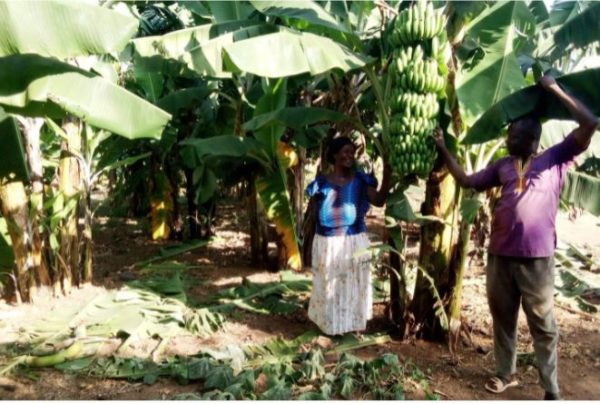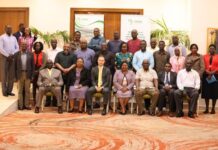Bananas are a staple food in Uganda. Every household in the program area where communities are partnering with World Neighbors has at least five banana plants in their gardens for subsistence. However, through World Neighbors’ intervention, smallholder farmers are now adopting commercial banana cultivation as a source of family income.
The current climate crisis has had a negative impact on agricultural production of all crops including bananas because agriculture is still primarily rain-fed. Droughts have become more frequent and so the farmers have to find ways of becoming resilient to the effects of climate change. Rain-fed banana cultivation has become risky because of the unpredictability of rainfall both in terms of timing and amounts.
World Neighbors has been working with communities in both Malongo and Bukabooli sub-Counties of Mayuge district in Uganda to improve their food security, diversify their livelihood sources and increase their incomes. Households have been growing mainly native banana cultivars that are sources of food and are also used for social and traditional functions.
The agricultural research institutes in Uganda are producing other varieties of bananas (improved cultivars) some of which are drought resilient and not susceptible to common banana diseases. One of these new varieties is the mpologoma which our program communities expressed an interest in acquiring and cultivating because it is high yielding.
In 2016, the program sourced 1,800 mpologoma banana suckers which were distributed to 18 farmers under a strategy known as ‘passing on the gift’. Under this strategy, farmers who receive the suckers are required to share suckers with other farmers once the original ones have been planted and produced their own suckers. In this way, many farmers benefit gradually. From the initial 18 famers, over 154 farmers have received over 6,000 suckers and are now active cultivators of the mpologoma variety. The number could have been higher but the frequent droughts have hindered the survival rates of the suckers.
A major challenge to the farmers is the frequent drought which reduces production as well as the speed of passing on suckers to other farmers who need them. Furthermore, because of the drought the survival rate of the suckers once they have been passed on is also low. The program therefore had to find ways of assisting farmers to address this challenge. Agronomic practices that increase soil fertility, promote small scale irrigation and ensure better water retention in the soil were given priority.
Agronomic practices
Mulching
Mulching has been encouraged because it reduces the amount of weeds in a plantation by choking the established weeds and denying sunlight to those that require it for germination. Additionally, mulch helps water to penetrate deeper into the soil and prolongs its retention. It also returns nutrients to the soil as it rots, thus improving soil fertility and yield. The following are some of the sources of mulch in the program area:
- Banana plant residues: When leaves get old they are pruned off and spread between rows of the banana plants. Only those leaves whose green part is less than 50% are cut off. In addition, the stems of harvested bananas are also split and placed between the rows as mulching materials.
- Annual crop residues: These include maize stalks, bean trash, rice stalks, etc.
- Grasses: These include elephant grass and swamp grasses.
Banana farmers have adopted the skill of mulching although it is advisable to place the mulch at least 50 cm. from the banana stem in order to avoid the proliferation of pests that may attack the banana plant.
Mulching has played a crucial role in water and soil conservation in the banana gardens. This is because the mulches cover the soil and prevent soil erosion by reducing the impact of the rain drops and hence preventing surface run off thus conserving the soil and water for the banana plants to thrive. It is practiced to ensure reduction of runoff and improved water filtration into and retention in the soil. Mulching has been successful in the program after a number of sensitization and awareness trainings conducted with the farmers to enhance their knowledge and skills.
Irrigation
The program acquired a number of portable hand pumps for farmers to use in turns to irrigate their banana plantations, particularly during the dry season. The pumps are managed by the Parish program management committees to ensure fair usage by all farmers when they need them. When it rains, farmers harvest the rain water by digging water pans, trenches or wells near or on their farms.
Farmers who live near a perennial river or on the shores of Lake Victoria use the water directly from those sources for irrigation. The pump is then used to extract water which is used to water the plants. Farmers pay some little amount for using the pumps. These levies are used to repair the pumps and in cases where the amounts collected are enough, extra pumps have been purchased. Some farmers have also organized themselves into groups and contributed money to purchase their own pumps after realizing that irrigation improves yields and by acquiring their own pumps they reduce the waiting time to have access to the Parish managed pumps since they are in high demand.
Livestock fodder
Most farmers also keep cows, goats, sheep and pigs. While the majority still practice free range feeding of the animals, with the decreasing sizes of family land holdings in situ feeding of the animals is becoming common. The World Neighbors program also introduced dairy goats to the communities. These goats must be housed in an appropriate pens and fed and watered in situ. Livestock fodder production has now become an important activity in the community. There are a number of methods for utilizing leaves to prepare fodder for livestock. And because banana is the most cultivated crop, its leaves are readily available for fodder preparation.
Raw fodder: Here farmers get fresh fodder/grazing materials including banana leaves and peels right from the source to the animals for feeding. These contain water and ready nutrients for the animals.
Hay making: Fodder is collected, mainly during the rainy season when it is plenty, put in a dry cool place and left to dry for some time. It is later used to feed livestock during periods of scarcity, particularly during the dry period. This practice has been adopted by most farmers due to the high frequency of drought. Additionally, because livestock are fed in situ, this reduces their chances of being infected when they are grazed free range.
Silage: In this type, dry banana leaves, grass and maize stalk are mixed with sugary liquids such as molasses and left to dry. When the mixture is ground, it is referred to as silage. It is very nutritious and liked by livestock. Its preparation is, however, time and resource consuming, hence cannot be afforded by poor farmers.
The impact
Banana production has greatly improved food and nutrition security in the community. Bananas are also a source of income as surplus produce is sold in the local markets for as much as USD 8 per bunch during the dry season. It has also encouraged a mixed farming system (keeping of livestock and cultivation of crops) as banana leaves and trunks provide fodder for livestock, and are suitable for making compost manure.
Over 100 farmers have been trained in farm preparation, planting and management practices on the basis of training of trainers. Those who have been trained also train others in their villages and parishes, hence spreading the knowledge and skills to more farmers. The program has also begun to train the farmers on banana value chain and collective marketing.
They are also being trained in value addition and have begun to make cakes, buns and crisps for sale. The production of bananas has increased as a result of the adoption of better agronomic skills by the farmers. This has led to increased incomes of households who produce surplus for sale.
Because incomes have increased, household members (particularly women) are able to save through joining existing savings and credit groups where they secure loans for initiating income generating activities. Households have also been able to purchase more dairy goats whose milk is nutritious and boosts the human immune system. Dairy goats sell at a higher price than the indigenous breeds, and their milk is more expensive than cow milk, hence fetch better prices.
The dairy goats have improved the livelihoods of the community members by:
- Improving their nutrition intake through access to milk and meat. Goat milk is rich in minerals such as calcium, iron and phosphorous that are vital for those with low/weak immune systems such as children under five years and PLHIV.
- Diversifying income sources and increasing incomes through the sale of milk, meat and goats.
- Improving crop production through the use of goat manure to improve soil health.









